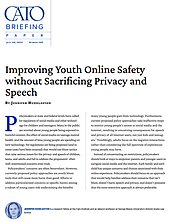1. Jennifer Huddleston, “Would New Legislation Actually Make Kids Safer Online? Analyzing the Consequences of Recent Youth Online Safety Proposals,” Cato Institute Briefing Paper no. 150, April 6, 2023.
2. See “Ongoing Series: Moral Panics / Techno-Panics,” Technology Liberation Front (blog).
3. Reno v. American Civil Liberties Union, 521 U.S. 844 (June 26, 1997).
4. NetChoice v. Bonta, No. 5:22-cv-08861-BLF (N.D. Cal. filed February 24, 2023).
5. See “Use Parental Controls on Your Child’s iPhone, iPad, and iPod Touch,” Apple Support, September 12, 2022.
6. See “Verizon Smart FamilyTM FAQs,” Support, Verizon.
7. “For Parents: Helping Your Teen Navigate Instagram Safely,” Community, Instagram.
8. “Good Digital Parenting,” Family Online Safety Institute; and “Parent Guides from ConnectSafely,” ConnectSafely.
9. Madeline Holcombe, “For Adolescents, Social Media Might Be a Brain-Changer, Researchers Say,” CNN, January 4, 2023.
10. Leana S. Wen, “Social Media Is Devastating Teens’ Mental Health. Here’s What Parents Can Do,” Washington Post, March 21, 2023.
11. Peter Suciu, “Social Media Isn’t Actually Creating Anxiety or Depression in Teens,” Forbes, November 4, 2019.
12. Anya Kamenetz, “The Scientific Debate over Teens, Screens and Mental Health,” NPR, August 27, 2019.
13. Leana S. Wen, “The Checkup with Dr. Wen: Yes, Social Media Use Is Linked to Depression in Teens,” Washington Post, March 23, 2023; and “Teens’ Social Media Use Does Not Raise Risk for Depression: Study,” Mailman School of Public Health, Columbia University, August 11, 2020.
14. Taylor Barkley, “What Should Policymakers Do about Social Media and Minors?,” Center for Growth and Opportunity, Utah State University, March 23, 2023.
15. Emily Weinstein, “The Social Media See-Saw: Positive and Negative Influences on Adolescents’ Affective Well-Being,” New Media & Society 20, no. 10 (2018): 3597–623.
16. Ben Knight, “Small Exposure to Body Positive Content Can Improve Body Image,” Newsroom, University of New South Wales, January 6, 2023.
17. Benjamin Kaveladze, “Online Communities Pose Risks for Children, but They Are Also Important Sources of Support,” PhillyVoice, May 14, 2021.
18. Craig Chamberlain, “Benefits of Online Interaction for Teens Outweigh Danger, Professor Says,” News Bureau, Public Affairs, University of Illinois Urbana-Champaign, November 6, 2007.
19. Annabel Latham, “Cambridge Analytica Scandal: Legitimate Researchers Using Facebook Data Could Be Collateral Damage,” The Conversation, March 20, 2018.
20. “Teens’ Social Media Use Does Not Raise Risk for Depression: Study,” Mailman School of Public Health, Columbia University, October 3, 2022.
21. Claire Cain Miller, “For One Group of Teenagers, Social Media Seems a Clear Net Benefit,” New York Times, May 24, 2023.
22. Leana S. Wen, “The Checkup with Dr. Wen: Yes, Social Media Use Is Linked to Depression in Teens,” Washington Post, March 23, 2023.
23. Megan McCluskey, “For Teens, Saving Each Other From Social Media Is a Team Effort,” Time, May 25, 2022.
24. Project Rockit website, https://www.projectrockit.com.au/.
25. “Social Media Fact Sheet,” Pew Research Center, April 7, 2021.
26. “Written Comments in Support of IN HB 1358,” Computer & Communications Industry Association; and Jesse Scheckner, “ ‘We’re Losing These Kids’: Panel Updates Bill Requiring Social Media Safety Lessons in Public School,” Florida Politics, February 7, 2023.
27. “Be Internet Awesome,” Google; “Bullying and Cyberbullying Prevention Strategies and Resources,” Anti-Defamation League, September 12, 2012; and “Get Real! Digital Media Literacy Toolkit,” National Eating Disorders Association.


